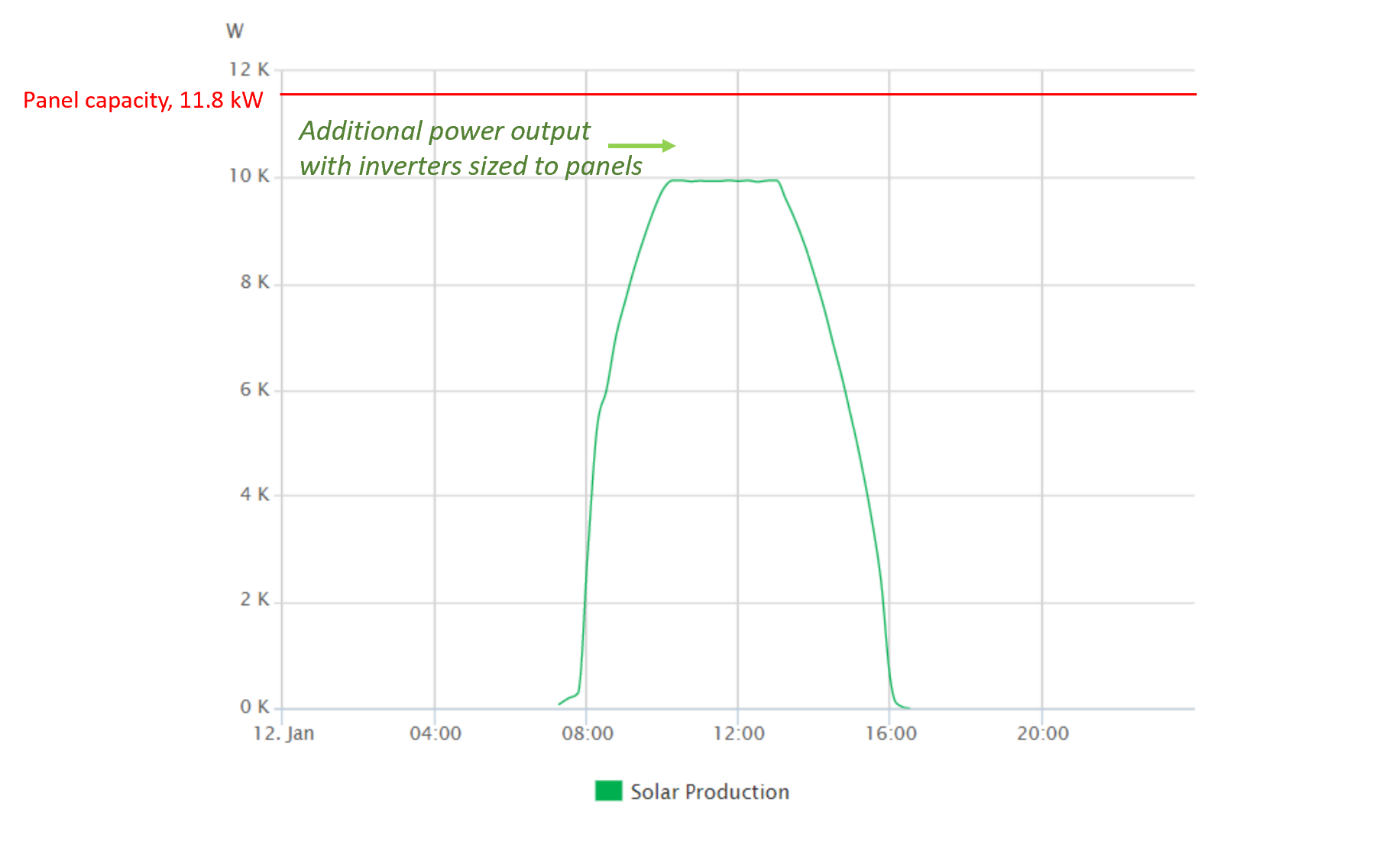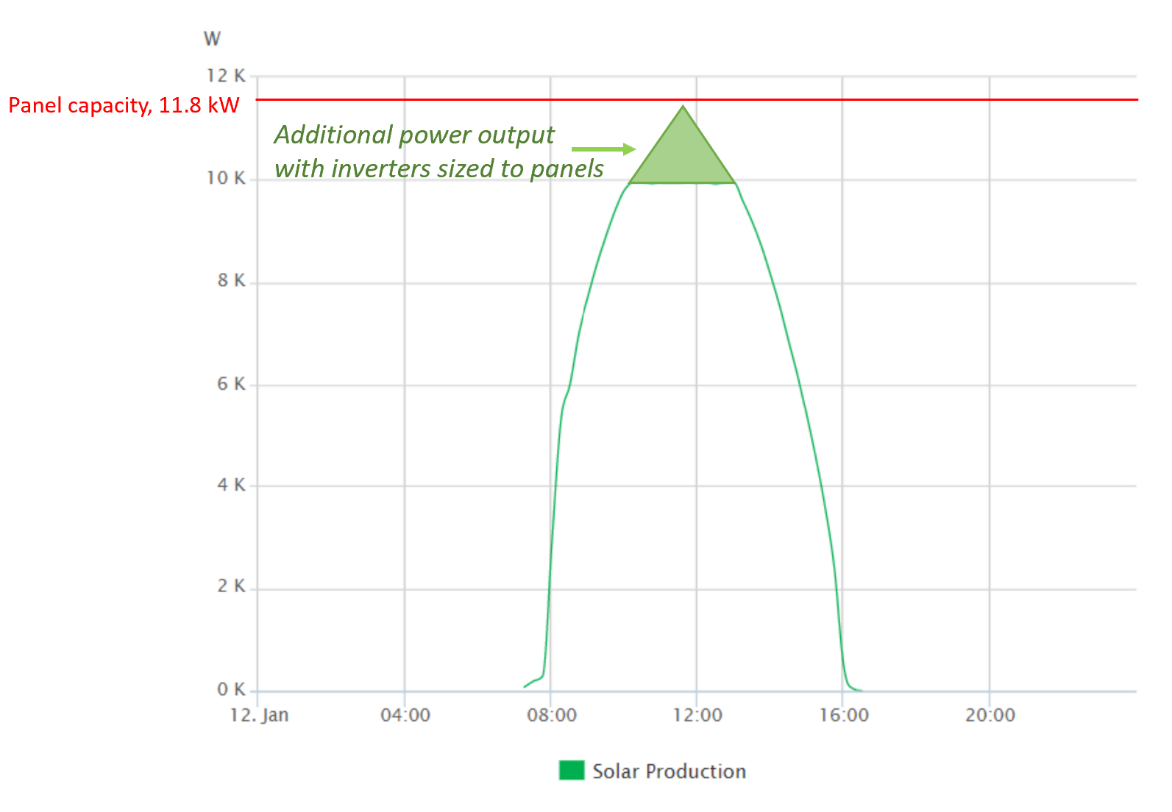One great thing about going solar in the computer age is all the detailed information you can access about your system’s performance.
But, on very sunny days, you may notice something puzzling.
At mid-day, when your panels are getting maximal sunlight, their power output may suddenly flatline before reaching full capacity—a phenomenon known as “solar clipping.”
Some homeowners naturally assume it’s a sign that something must be wrong.
But, in a properly designed solar system, clipping isn’t a bug. It’s a feature that helps increase overall energy production.
An Example of Solar Clipping
Here’s a production graph for an 11.8-kilowatt (kW) solar system on a day that it clipped.
• A minimal amount of power starts getting generated after sunset
• Power output rapidly increases till around 10 am when it suddenly clips at 10 kW, only 85% of the system's capacity
• Output remains flat till around 1 pm when it starts rapidly decreasing, finally reaching zero at sunset
It sure looks like something was stopping these solar panels from producing all the power they could between 10 am and 1 pm.
And, as a matter of fact, another part of the system called an “inverter” was doing just that.
Inverters
Inverters change the DC current your solar panels produce into the AC current necessary to run your home.
But, importantly, every inverter also has a maximum amount of DC current it can handle at any given time.
The system we’re looking at has 40 solar panels each rated at 295 watts, for a total of 11,800 watts (11.8 kW). But each of the 40 panels is paired with an inventor that's only rated at 250 Watts, capping the maximum power output of the whole system at only 10,000 watts.
So, even when it’s sunny enough for the panels to reach their full capacity of 11.8 kW, they won’t generate that much power because the inverters will keep them“clipped” down to a 10-kW maximum.
it's natural to assume that the designer must have made a mistake. But nothing could be further from the truth.
Increased cost, minimal payoff
For one thing, higher-capacity inverters cost more.
But they only serve a purpose on the sunniest mid-summer days—and even then only for a few hours during midday when your panels might reach their maximum capacity.
As the graph below shows, even on those rare occasions the payoff isn’t great.

Moreover, since heat decreases solar panel efficiency, it's even worse than it looks. The power gain that day would have been less than the graph depicts, amounting to well under 5%.
It’s unlikely getting that small of a payoff at most maybe 50 days a year could’ve justified the extra expense.
But there’s a second even bigger factor that seals the deal.
Higher capacity means less efficiency.
Like any physical change, converting DC power to AC takes energy. That means that you're always going to lose some in the process.
And it turns out that inverters run more efficiently the closer they get to their maximal capacity.
So, suppose the designer of our sample 11,800-watt system had used inverters that could've handled the tiny amount of extra power it's capable of generating for a few hours on the sunniest mid-summer days.
Besides costing more, increasing the inverters' maximum capacity means they'll be operating further away from it and, hence, less efficiently all the rest of the time.
Reducing clipping means reducing efficiency.
So, sure, no question about it… using higher capacity inverters would have increased panel output during the three hours our example system clipped.
But using higher-capacity inverters would've also made the solar panels operate less efficiently pretty much 100% of the time.
The upshot is that any small gain achieved by upsizing inverter capacity would’ve been wiped out by a much larger loss.
The Ideal ratio
It turns out that setting panel capacity at around 120% of inverter capacity will usually keep conversion losses below 0.25%, which is about the best you can do.
And what do you know?
The system featured in our graph had panels that could produce 11.8 kW of power paired with inverters that could only handle 10 kW. And 11.8 is 1.18% of 10, about as close to 120% as the designer could probably manage.
So it turns out they knew exactly what they were doing all along.
You just need to understand a little about how solar energy works to see it.